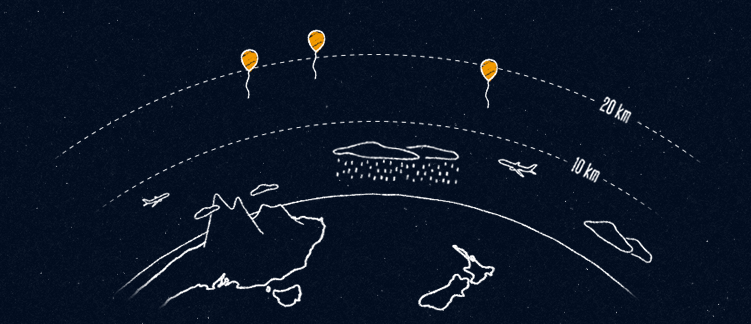Technology
Technology

Loon deploys its high-altitude balloon network into the stratosphere, between altitudes of 18km and 25km. The company states that the particular altitude and layer of the stratosphere is advantageous for the balloons because of its low wind speeds, which are usually recorded between 5mph and 20mph (10km/h to 30 km/h). The layer is also an area of minimal turbulence.
The company says it’s able to model the seasonal, longitudinal and latitudinal wind speed variations, allowing them to adjust the placements of their balloons.
Loon claims it can control the latitudinal and longitudinal position of its high-altitude balloons by changing their altitude. They do this by adjusting the volume and density of internal gas (which is composed of either helium, hydrogen or another lighter-than-air-compound), which allows the balloon’s variable buoyancy system to control the altitude.
Additionally, Google has indicated that the balloons are possibly constructed from materials like metalized Mylar, BoPET, or a highly flexible latex or rubber material, like chloroprene.
Initially, the balloons communicated using unlicensed 2.4 and 5.8 GHz ISM bands, and Google claims that the setup allows it to deliver "speeds comparable to 3G" to users, but they then switched to LTE with cellular spectrum by cooperating with local telecommunication operators. It is unclear how technologies that rely on short communications times (low latency pings), such as VoIP, might need to be modified to work in an environment similar to mobile phones where the signal may have to relay through multiple balloons before reaching the wider Internet.
Google also experimented with laser communication technology to interconnect balloons at high altitude and achieved a data rate of 155 Mbps over a distance of 62 miles (100 km).
The first person to connect to receive internet access from one of the Loon balloons was Charles Nimmo, a farmer and entrepreneur in Leeston, New Zealand. Nimmo was one of 50 people in the area around Christchurch who agreed to be a pilot tester for Loon.
The New Zealand farmer lived in a rural location that was unable to get broadband access to the Internet. The town’s residents used a satellite Internet service in 2009, but found that the service could reach costs of up to $1000 per month.
Locals who were not participating in the testing were not made aware of the details, other than that it had potential ability to deliver Internet connectivity, but allowed project workers to attach a basketball-sized receiver resembling a giant bright-red party balloon to an outside wall of their property in order to connect to the network.
The technology designed in the project could allow countries to avoid using expensive fiber cable that would have to be installed underground to allow users to connect to the Internet. Alphabet feels this will greatly increase Internet usage in developing countries in regions such as Africa and Southeast Asia that can't afford to lay underground fiber cable.
